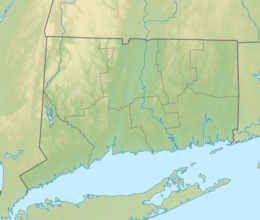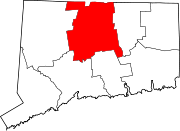This article has multiple issues. Please help
improve it or discuss these issues on the
talk page. (
Learn how and when to remove these template messages)
|
| Temple Beth Israel | |
|---|---|
 The current synagogue in
West Hartford, in 2008 | |
| Religion | |
| Affiliation | Reform Judaism |
| Ecclesiastical or organisational status | Synagogue |
| Leadership |
|
| Status | Active |
| Location | |
| Location | 701 Farmington Avenue, West Hartford, Connecticut 06119 |
| Country | United States |
Location in
Connecticut | |
| Geographic coordinates | 41°45′53″N 72°43′12″W / 41.76472°N 72.72000°W |
| Architecture | |
| Architect(s) |
|
| Type | Synagogue |
| Style | 1876: 1936: |
| Date established | 1843 (as a congregation) |
| Completed |
|
| Dome(s) |
|
| Website | |
|
cbict | |
Temple Beth Israel (1876) | |
 The first synagogue, now cultural center, in 2010 | |
| Location | 21 Charter Oak Avenue, Hartford, Connecticut |
| Coordinates | 41°45′33″N 72°40′29″W / 41.75917°N 72.67472°W |
| Area | 1 acre (0.40 ha) |
| NRHP reference No. | 78002868 |
| Added to NRHP | December 01, 1978 |
Temple Beth Israel (1936) | |
 The current synagogue building, in 2008 | |
| MPS | Historic Synagogues of Connecticut MPS |
| NRHP reference No. | 95001343 |
| Added to NRHP | November 27, 1995 |
| [1] [2] | |
Congregation Beth Israel ( transliterated from Hebrew as "House of Israel") is a Reform Jewish congregation and synagogue located at 701 Farmington Avenue, in West Hartford, Connecticut, in the United States.
Established in 1843, it is one of the two oldest Jewish congregations in Connecticut and one of the largest Reform congregations in New England, with about 900 member families and about 2,000 individual members.
Designed by George Keller in the Romanesque Revival style, the congregation's first synagogue building, commonly called the Charter Oak Temple, located in Hartford on Charter Oak Avenue, was completed in 1876 and was added to the National Register of Historic Places in 1978. [3] Designed by Charles R. Greco in the Art Deco and Byzantine Revival styles, the congregation's second and current building, located in West Hartford, was completed in 1936 and was added to the same register in 1995, [1] as part of a multiple property listing of fifteen historic synagogues in Connecticut. [4]
Architecture
The congregation occupies a large building dominated by an enormous Byzantine Revival dome. Inside are a sanctuary, upon which the dome is built, a chapel, a religious school, a pre-school, offices, two meeting halls, a small museum, and a library. Beautiful stained glass windows are present in both the sanctuary and the chapel.
The 1936 building was designed by Charles R. Greco and built at the height of the Art Deco period, the Byzantine revival form in Art Deco style presents a majestic appearance. In 2006, the congregation was given the West Hartford Historic Preservation Award for its meticulous restoration of the historic structure.[ citation needed]
The synagogue building was one of fifteen Connecticut synagogues added to the National Register of Historic Places in 1995 [1] and 1996 in response to an unprecedented multiple submission, nominating nineteen synagogues. [5] [4]
History
Founding and affiliation
Beth Israel was founded in 1843, the year the Connecticut legislature first permitted public worship by Jews in the state. Congregation Mishkan Israel was founded in the same year. [6] Congregation Beth Israel began as an Orthodox congregation, however, in part influenced by the immigration of German Jews to Hartford, the congregation quickly adopted Reform practices. In 1877, it joined with other American Reform Jewish congregations to form the Union of American Hebrew Congregations.
First synagogue
Congregation Beth Israel's first synagogue was built at 21 Charter Oak Avenue in Hartford in 1876. Though Beth Israel left the building in 1936, the building is occupied by the Charter Oak Cultural Center. It is among the oldest synagogue buildings still standing in the United States. [7]
Rabbi Feldman
Beth Israel moved into its present location in 1936. For most of the middle of the 20th century (1925–1977), the congregation was led by Rabbi Abraham J. Feldman, a leading exponent of Classical Reform philosophy. One of the innovations that Rabbi Feldman brought to Congregation Beth Israel was the confirmation ceremony at age 16.
Feldman's influence was far reaching.[ citation needed] He fostered a sense of community and was held in great respect by most, if not all, of the congregation.[ peacock prose] He focused on building a congregation that people stayed in for a long time and celebrated all their life events as a congregation. His long service as rabbi meant that many people were born, confirmed, and married under his leadership. Indeed, even at the beginning of the 21st century, a number of older congregants would use his leadership and rabbinate as an example.
Rabbi Silver
This section needs additional citations for
verification. (January 2024) |
Rabbi Harold Silver succeeded Feldman in 1968. He would serve as senior rabbi for 25 years, retiring in 1993. Silver came from a family of rabbis. Five generations of his family before him served as rabbis. His father, Maxwell Silver, was a rabbi in New York City; his uncle, Abba Hillel Silver, was a rabbi in Cleveland, Ohio; and his grandfather, Moses Silver, was a rabbi in Jerusalem. Silver was ordained in 1951 at Hebrew Union College in New York City. Rabbi Silver's first rabbinate was as assistant rabbi at the Rodef Shalom Congregation in Pittsburgh. He went on to become rabbi at Temple Emanuel in Pittsburgh, where he served from 1955 until he came to Congregation Beth Israel in 1968.
Silver was prominent in the Hartford Jewish community. He organized the first Greater Hartford Rabbinical Board of Rabbis, which brought together rabbis from different Jewish congregations and movements. He also served on a variety of community boards, both Jewish and non-Jewish. Silver also promoted cross-religious interfaith dialogue, preaching at many local churches and encouraging peace and understanding between people of different faiths. Additionally, Silver taught Judaism courses at local universities. He hired Connecticut's first female associate rabbi, Jody Cohen, bringing her to Beth Israel in 1984.
Silver retired in 1993 and became rabbi emeritus. He died on March 9, 2017, aged 92 years. [8]
Rabbi Glaser
Silver was succeeded by Rabbi Simeon Glaser, who has served as assistant rabbi at Congregation Beth Israel at the end of Rabbi Silver's tenure as senior rabbi. Glaser was particularly popular with young families and children because of his love, and evident talent, for music and song. Glaser put on exciting Purim and Simchas Torah holiday services in which he would team up with Cantor Green and Assistant Rabbi Weiss to sing, dance, and act out the stories of the holidays. After serving four years as senior rabbi, Glaser left Beth Israel, first to serve at a small Conservative synagogue in Wethersfield, Connecticut and then to Temple Israel in Minneapolis, Minnesota.
Soviet immigration
During the 1990s, Congregation Beth Israel became instrumental in the absorption of hundreds of Jewish immigrants from the former Soviet Union. Early on, the New American Committee was formed to provide education assistance, licensure help, clothing acquisition assistance and help with the home needs of the new Americans. The New American Committee also continues to provide educational opportunities including lectures and weekly language classes. Congregation Beth Israel now[ when?] has a large Russian speaking population and immigrants make up a significant demographic of the congregation.
Rabbi Fuchs
Rabbi Stephen Fuchs became senior rabbi in 1997 and has served as Rabbi Emeritus since 2011.
See also
- National Register of Historic Places listings in West Hartford, Connecticut
- Oldest synagogues in the United States
- Universal Health Care Foundation of Connecticut
References
- ^ a b c "National Register Information System". National Register of Historic Places. National Park Service. March 13, 2009.
- ^ "Temple Beth Israel: 95001343". National Register of Historic Places. National Parks Service. November 27, 1995. Retrieved January 13, 2024.
- ^ Ransom, David F. (December 1, 1978). "Nomination form: Temple Beth Israel". National Register of Historic Places. National Park Service. Retrieved December 11, 2014.
- ^ a b Ransom, David F. (March 29, 1995). "NRHP Registration Form Multiple Property Listing: Historic Synagogues of Connecticut". National Park Service. Retrieved July 31, 2010.
- ^ Charles, Eleanor (April 7, 1996). "In the Region/Connecticut;15 Synagogues Gain National Landmark Status". New York Times. Retrieved July 31, 2010.
- ^ Olitzky, Kerry M.; Raphael, Marc Lee (June 30, 1996). The American Synagogue: A Historical Dictionary and Sourcebook. Greenwood Press. pp. 76–80.
- ^ Gordon, Mark W. (1996). "Rediscovering Jewish Infrastructure: Update on United States Nineteenth Century Synagogues". American Jewish History. 84 (1) (2019 update ed.): 11–27.
- ^ "Obituary: Harold Silver". Legacy.com.
External links
- Official website
- "National Register of Historic Places". National Parks Service. Archived from the original on January 20, 2007.
- "Ellen Jeanne Goldfarb Community Learning Center". Archived from the original on July 5, 2008.
- "Home page". Charter Oak Center.
- 1843 establishments in Connecticut
- 20th-century synagogues in the United States
- Art Deco architecture in Connecticut
- Art Deco synagogues
- Buildings and structures in West Hartford, Connecticut
- Byzantine Revival architecture in Connecticut
- Byzantine Revival synagogues
- Founding members of the Union for Reform Judaism
- German-American culture in Connecticut
- German-Jewish culture in the United States
- Jewish organizations established in 1843
- National Register of Historic Places in Hartford County, Connecticut
- Reform synagogues in Connecticut
- Synagogues completed in 1933
- Synagogues completed in 1936
- Synagogues on the National Register of Historic Places in Connecticut



